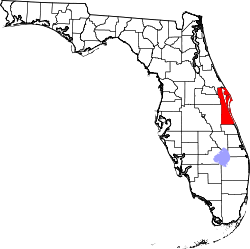Eau Gallie, Florida
| Eau Gallie, Florida | |
|---|---|
| Neighborhood of Melbourne | |
| Coordinates: 28°07′45″N 80°37′48″W / 28.12917°N 80.63000°WCoordinates: 28°07′45″N 80°37′48″W / 28.12917°N 80.63000°W | |
| Country |
|
| State |
|
| County |
|
| City |
|
| Settled | 1859 |
| First settler | John Caroll Houston, IV |
| Incorporated | 1860 |
| Consolidated with Melbourne | 1969 |
| Founded by | William Henry Gleason |
| Time zone | Eastern (UTC-5:00) |
| • Summer (DST) | Eastern (UTC-4:00) |
Eau Gallie (IPA: /oʊ ˈgæːli/)[1] is a section of the city of Melbourne, Florida, located on the city's northern side. It was formerly an independent city in Brevard County from 1860 until 1969, when the citizens of Eau Gallie and Melbourne voted to merge. A subsequent vote among the citizens resulted in the new cities being named Melbourne. The name and identity of Eau Gallie persists in a number of local entities.
History
A post office called Eau Gallie was established in 1871, and remained in operation until it was discontinued in 1970.[2] The Kentucky Military Institute wintered in Eau Gallie from 1907 to 1921.
Eau Gallie is commonly said to mean "rocky water", since coquina rocks were found in the area. While eau means "water" in French, gallie is not a French word and may be derived from galet ("pebble" in French). Some attribute it a Chippewa word; however, Chippewa speakers lived much farther north of Florida.[3]
Economy
Eau Gallie is an authentic Florida community with original historic buildings, live oaks and native plants located on the Indian River Lagoon. Anchored by the Eau Gallie Civic Center, Library, and Public Pier, as well as Pineapple Park with a lighted gazebo and riverwalk, Foosaner Art Museum/FIT, and the Renee Foosaner Education Center. The Historic Rossetter House Museum and Gardens, which is on the National Register of Historic Places offers home tours and rental space for private events. Home to the Brevard Symphony Orchestra and the Junior League of South Brevard, and fine art galleries along historic Highland Avenue. It is home to the Eau Gallie Arts District Main Street program, an award winning, fully accredited Florida and National Main Street organization devoted to the preservation of its historical assets and redevelopment of the central business area.<www.eaugalliearts.com>
Historic section
Eau Gallie contains a historic area with several notable museums and houses. These include: the Advent Christian Church, Foosaner Art Museum, the Ginter Building, the Historic Rossetter House Museum, the James Wadsworth Rossetter House on the National Register of Historic Places, the Karrick Building, the Roesch House, and the Winchester Symphony House.
An area of 14.31 acres (5.79 ha), containing 31 houses, is petitioning for official recognition as a Historic District. The first permanent settler, John Carroll Houston, arrived in 1859.[4]
Notable people
- Thomas Barbour, herpetologist. Aged 14 years in 1898, he lived in Eau Gallie with his grandmother.[5] There he developed his love for nature.
- Zora Neale Hurston, author, lived in cottage on Guava Avenue and Fifth Street twice, first in 1929 and again in 1951[6]
- Mark Boswell, film director, lived in house at corner of Pineapple Avenue and Montreal Blvd. from 1990-1992.
- Evan Freymiller | Software developer, who lived in a house in Kings Mill 1990-2006. He is a major contributor to software development at the General Motors Company.
See also
- List of mayors of Eau Gallie, Florida
- Eau Gallie High School, originally on Pineapple Avenue, is named after this area
- Eau Gallie Public Library
- Eau Gallie Causeway
- Eau Gallie River
Notes
- ↑ http://eaugallie.com/
- ↑ "Brevard County". Jim Forte Postal History. Retrieved 7 June 2015.
- ↑ "Eau Gallie means 'rocky water'". Florida Today. Melbourne, FL. 2006.
[...] from the French word "eau," meaning water, and the French word "galet," meaning pebble, yielding "pebbly water," a somewhat loose translation of "rocky water. [...] [Francis Reid, reference librarian] discounted the Indian connection, saying Chippewas were concentrated in the north central United States and southern Canada."
- ↑ Cervenka, Suzanne (November 19, 2011). "Neighborhood seeks historic designation". Florida Today. Melbourne, Florida. pp. 2B.
- ↑
- ↑ Scott, Megan K. (6 March 2011). "Hurston's real home". Florida Today. Melbourne, Florida. pp. 1D.
References
- Eau Gallie Hiking Trail
- Noreda B. McKemy and Elaine Murray Stone, Melbourne Bicentennial Book. July 4, 1976. Library of Congress 76-020298.
External links
| Wikimedia Commons has media related to Eau Gallie, Florida. |
